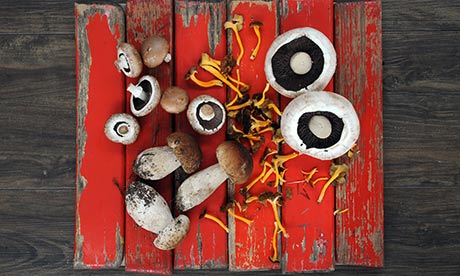
Having mushrooms in the fridge promotes a sense of security in the cook. In minutes, you've got mushrooms on toast, or a rapid blended soup. A little longer, and there's risotto or an easy pasta. It's the only non-meat that comes close to aping the flavours of meat, so you can rely on mushrooms to bring an intensely savoury "umami" character to a dish. Partnered with cream, cheese and ham, mushrooms take on a velvety richness. Just a hint of truffle oil makes them positively aristocratic.
With chestnut and cremini mushrooms available, it's hard to be enthused by the standard white sort. But the portobellos and the big, black-gilled field mushrooms have a distinctly meaty personality. If you know how to recognise edible species, then now's the time to forage the woods for fragrant chanterelles and boletus. Don't get it wrong though – one bad mushroom can kill you.
Why are mushrooms good for me?
In the absence of sunlight or supplements, eating mushrooms is a good way to up your vitamin D levels, and the only vegetarian food source of vitamin D (ergosterols in mushrooms convert to vitamin D when exposed to light). Vitamin D deficiency is thought to be quite widespread in Britain.
They are also a good source of B vitamins, which help provide energy by breaking down proteins, fats and carbohydrates, and play a key role in the nervous system. Betaglucans in mushrooms appear to boost immunity and help resistance against allergies. The selenium and ergothioneine may help protect our cells from damage that causes chronic disease.
Where to buy and what to pay
Mushrooms are lovely and cheap. Per kilo, you'll pay from £2.60 (standard whites), £4-5 for chestnuts, and £14-15 for speciality types (shitake/enoki).
• Joanna Blythman is the author of What to Eat (Fourth Estate, £9.99). To order a copy for £7.99 with free UK p&p, go to guardianbookshop.co.uk
Baked mushrooms and eggs
This dish makes a wonderful supper, lunch or starter. I vary what kind of mushroom I use depending on the season or what I can find. At this time of year (weather dependent) a mixture of chestnut mushrooms and penny buns (cepes in french, porcini in Italian) would be my firm favourite. I have stipulated a higher weight of wild mushrooms since they tend to need more trimming and cleaning. If you can save any wild mushroom trimmings, wash them thoroughly and use to make a delicious stock or dry in a very low oven and whizz to a powder to add to soups, stews or gravies. Depending on which wild mushrooms I use I might also exchange tarragon for parsley. We have a version of this dish on our breakfast menu at Fitzbillies.
Serves 4
1 tbsp olive oil
50g butter
2 shallots, peeled and finely sliced
6 flat mushrooms/450g chestnut or button mushrooms/550g wild mushrooms; cleaned, trimmed and chopped into bitesize pieces
3 sprigs tarragon, leaves chopped
4 tbsp creme fraiche
4 eggs
Salt and pepper
1 Heat the oil in the pan over a medium heat and add a generous knob of butter. Add the shallots and cook gently for 7 or so minutes to soften, stirring regularly to avoid burning.
2 Add all but a tsp of butter and the mushrooms, turn the heat up and fry the mushrooms so that they get a bit of colour. Continue cooking, moving so they cook evenly, until they start to soften and the liquid evaporates this evaporate. Add salt, pepper and tarragon to taste. Remove from the heat and set aside.
3 Preheat the oven to 180C/350F/gas mark 4 and butter 4 small (about 8cm diameter) ramekins. Divide the mushrooms between the 4 ramekins. Spoon in half the creme fraiche. Make a dip in the centre of each ramekin and crack an egg in, being careful not to break the yolk. Season with salt and pepper, spoon on the rest of the creme fraiche and put in the oven for about 15 minutes, or until the white is cooked but the yolk is still runny. Serve straight away with toast and salad.
Rosie Sykes is head chef of Fitzbillies and co-author of The Kitchen Revolution (Ebury Press, £25). To order a copy for £19.99 with free UK p& go to guardianbookshop.co.uk

